
Connecting You to Door County’s Vital Lands & Waters
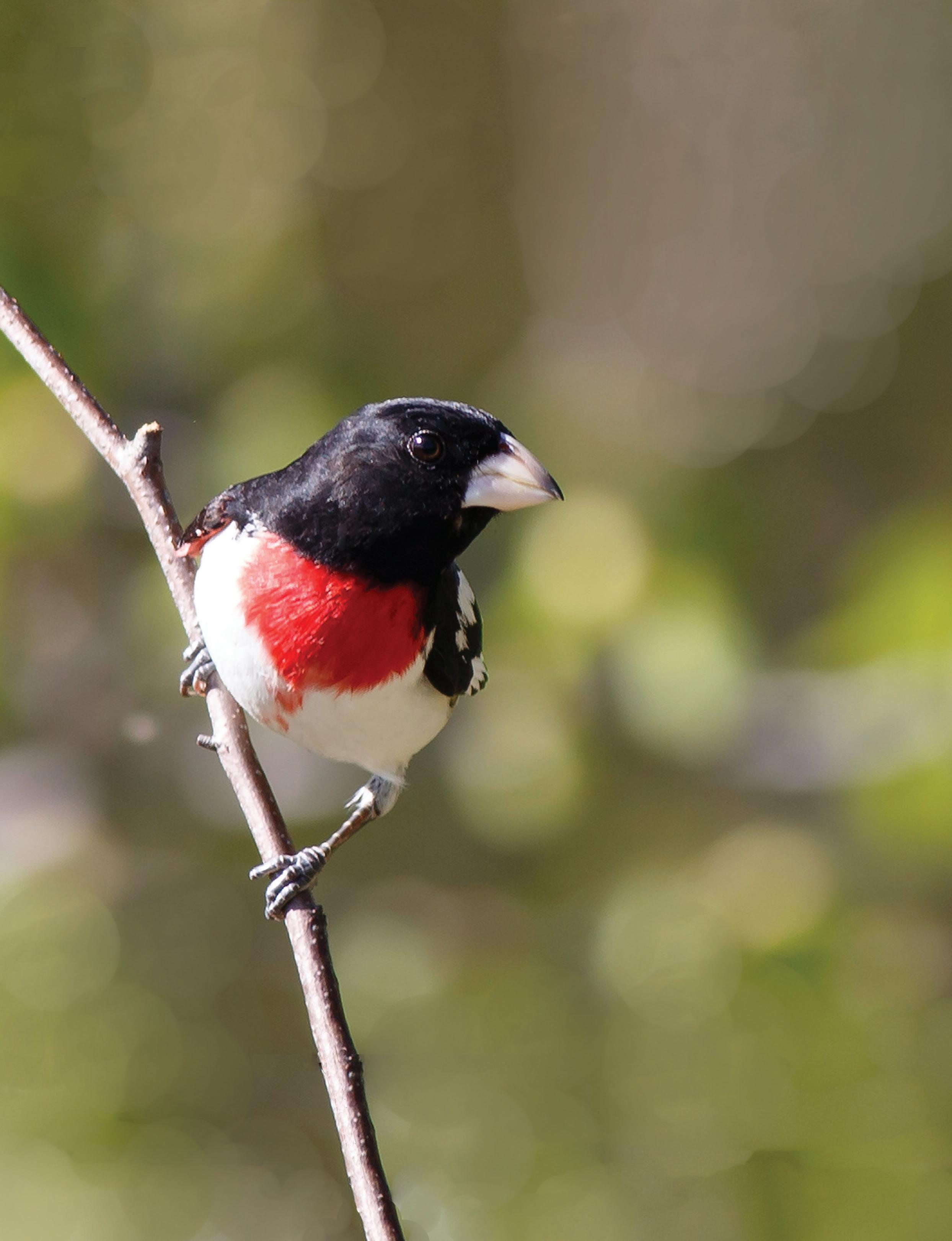
Making Connections for Conservation
Islands: Crucial Stepping Stones for Migration
Wildlife Corridors: Linking Lands for Protection
Photo by Naseem Reza
Journal of the Door County Land Trust Spring 2024, Vol. 27, Issue 1

Door County Land Trust protects the wild places, scenic beauty, and ecological integrity that make the peninsula and islands so special. The Land Trust is a local, member supported, non-profit organization. It is thanks to members and donors that more than 9,400 acres are now protected.
Land Trust nature preserves, located throughout Door County, are open for hiking, and other low-impact, non-motorized recreational activities—all at no charge to the public.
Meet the Staff
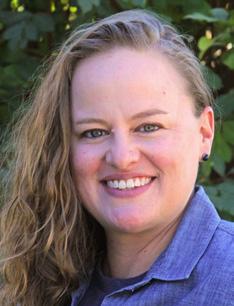
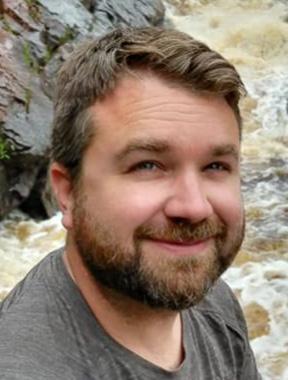
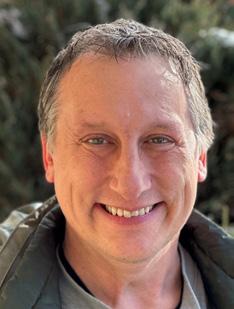

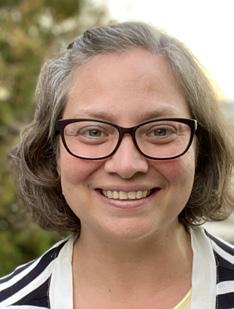

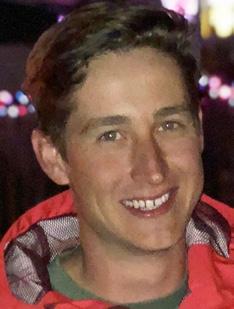


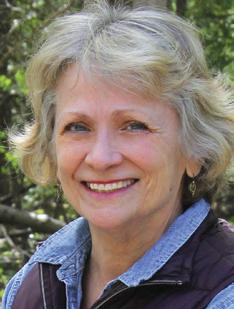


Executive Director
Emily Wood
Land Program Director
Jesse Koyen
Land Protection Manager
Brian Forest
Conservation Easement Manager
Drew Reinke
Land Project Manager
Carrie Ehrfurth
Ecological Restoration Manager
Tina Lee
Land Stewardship Specialist
Thomas Stasiak
Community Conservation Coordinator
Paige Witek
Director of Charitable Giving
Cinnamon Rossman
Communications Coordinator
Kay McKinley
Administrative Director
Kristi Rice
Administrative Assistant
Amy Dwyer
Mailing: PO Box 65, Sturgeon Bay, WI 54235
Phone: (920)746-1359
Email: info@DoorCountyLandTrust.org
www.DoorCountyLandTrust.org
Board of Directors
President
Roy Thilly
President-Elect
Deb Hagman-Shannon
Treasurer
Bob Ling
Secretary
Jeff Ottum
Meredith Coulson-Kanter
Peter Deschler
Barbara Frank
Donna Hake
Mark Holey
Mark Martin
Bryan Nelson
Anna Pepelnjak
Rick Scott
Past Board Members
Nancy Aten
Bob Barlament *
Jean Barrett
Tom Blackwood
Mike Brodd
Dan Burke
Fran Burton
Dave Callsen
Beth Coleman
Andy Coulson
Robert Cowles *
Donna DeNardo
Sharon Donegan
Frank Failing *
Jack Finger
Cathy Fiorato
Robert Forsberg
Darlene Forsberg
Ken Gill
Betsy Guenzel *
Julie Guilette
Chan Harris *
Tony Haswell
Jon Hollingshead
Laurel Hauser
Jim Janning
John Jessup
Jim Ingwersen *
Jim Kinney
Lucy Klug
Lon Kopitzke
Terry Lappin
Jim Lester
Judy Lokken
Paul Mahlberg
Neil McCarty
John McMahon
Beverly Njaa *
Kevin Nordahl
Frank Pechman *
Judy Perkins
Nancy Rafal
Kate Rohrer
Gretchen Schmelzer
Carl Scholz
Neil Shadle
Oliver Skrivanie
Mary Standish
Tim Stone
Bill Tischler *
John Turner
Kieth Van Dyke
Rob Van Gemert
Rob Watson
John Wilson *
Kathy Wolff
Karen Yancey
Robert Yeoman
Bill Yunker *
Virginia Yunker *
Elizabeth Zimmerman
James Zimmerman *
* Founding Members
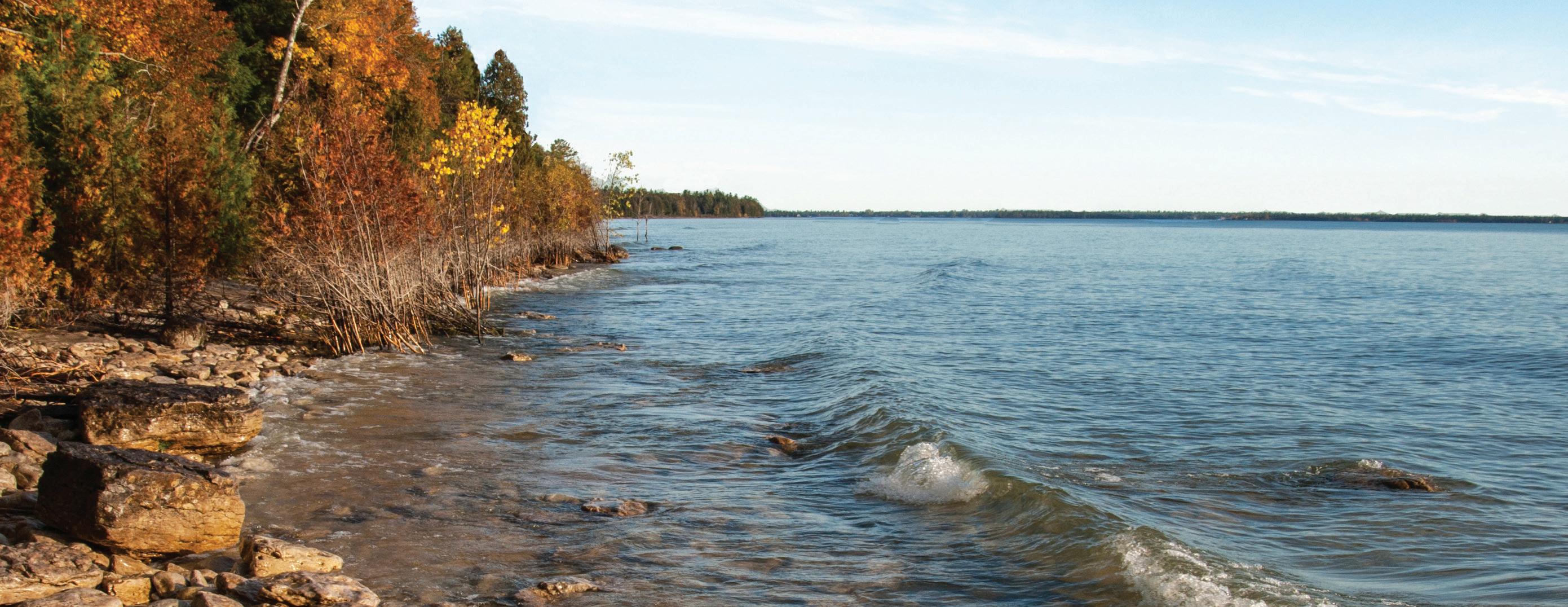
Your Legacy Will Live Forever. Legacy Circle Contact us at (920)746-1359 or email giving@DoorCountyLandTrust.org Planned giving through the Legacy Circle protects Door County’s vital lands and waters...forever. Please consider the Land Trust in your estate plans. In 2024, notify us of your intent to join the Legacy Circle and $1,000 will be donated in your honor. DoorCountyLandTrust.org/legacy
Drew Reinke
Jesse Koyen
Emily Wood
Kay McKinley Cinnamon Rossman
Amy Dwyer
Kristi Rice
Brian Forest
Paige Witek
Carrie Ehrfurth
Tina Lee Thomas Stasiak
Photo by Dan Eggert
Celebrating Connections Between Lands, People & Nature
Iwonder if the birds notice that this place is exceptional when they are migrating through. Do they start dreaming of the spectacular forests and sparkling bays while they are flying over the hundreds of miles of construction in Milwaukee—or is that just me?
Connections to nature are fundamental to human well-being. From the soothing sound of rustling leaves to the vibrant colors of a blooming flower, nature captivates our senses and restores our souls. Whether it’s a wander through a forest, the invigorating crash of waves against the shore, or the simple act of tending to a garden, nature offers us moments of tranquility and inspiration. These connections remind us of our place in the world. Through nature, we find solace, rejuvenation, and a profound appreciation for the beauty and interconnectedness of all living things.
In this issue of Landings we explore connection. We take a deep dive into how migratory species utilize corridors to safely travel across fragmented landscapes—and how we are engaging the community in projects that help us understand

how to best steward these places to ensure that they can thrive for generations.
As members of the Door County community, you play a pivotal role in preserving these connections. Your unwavering support, whether through membership, volunteering, or sharing our mission with others, is a testament to your commitment to something greater than ourselves—the preservation of our shared natural history.
So let us continue to nurture and celebrate these connections —between lands, between people, and within nature itself. We have this one chance to ensure that the vital threads of life remain unbroken—and we can only do it if we stick together.
 Emily Wood Executive Director
Emily Wood Executive Director
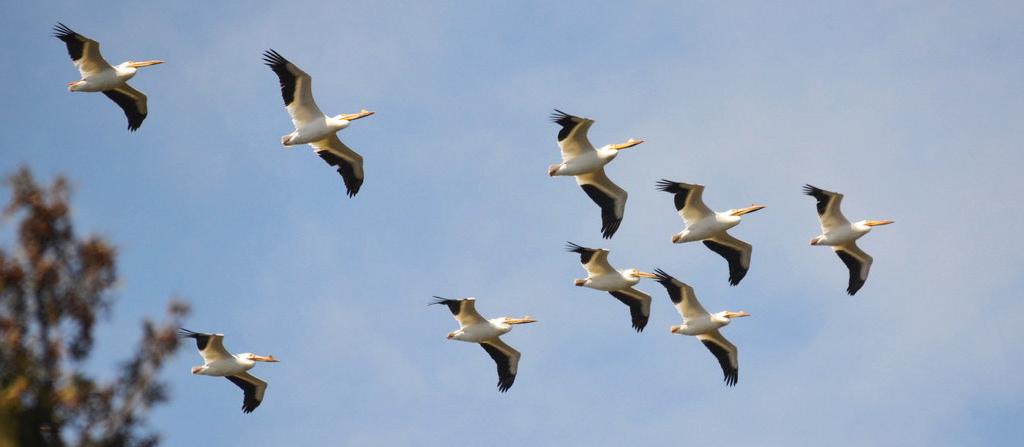
3
Landings —Spring 2024
Photo by Jeff Ortinau
Door
County Land Trust
Our cottage borders one of the Land Trust preserves and the nighttime calls of the Barred Owl are one of my favorite things about it!
This preserve site was my favorite new find this summer. Thanks to all who maintain this area!
- Lynn Sommers
- Pam Mehnert
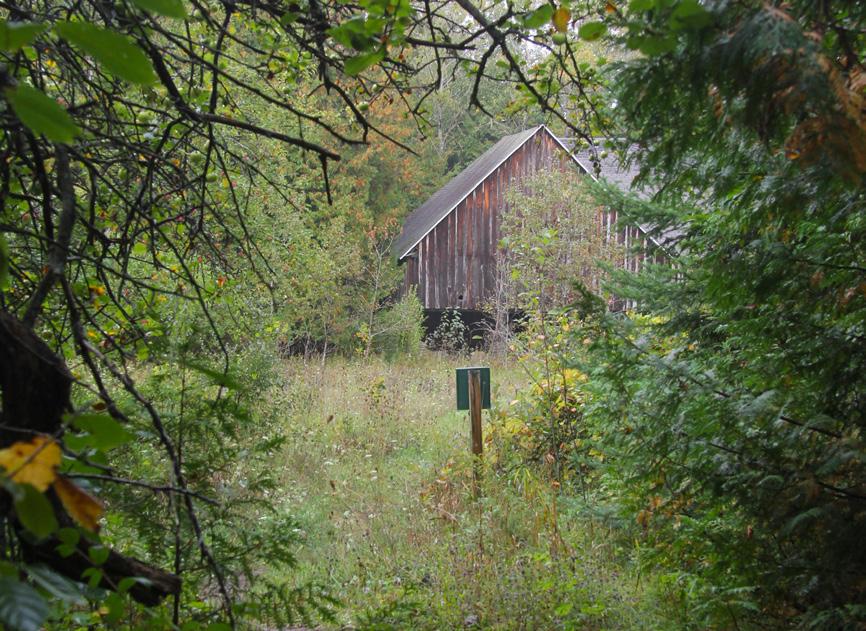


I really appreciate all the work you people are doing. Not easy being a leader in today’s modern world. Just keep doing it.
-James L. Johnson (Thanks for
your artwork, James!)
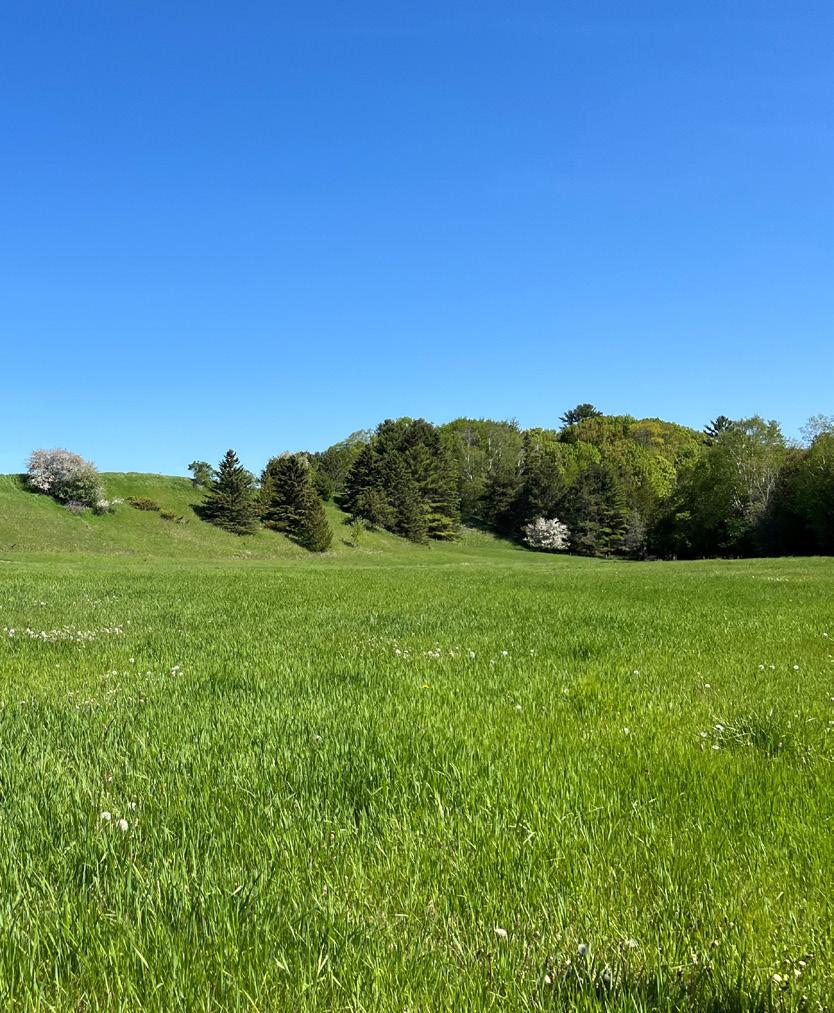
Happy to have another nature preserve in the southern part of Door County.
- Patty Melchior Quinn
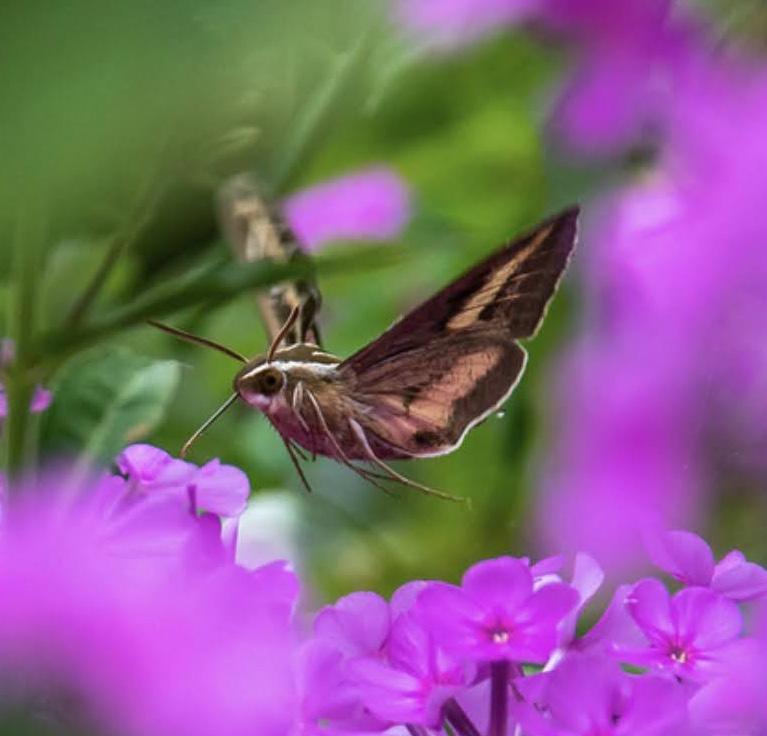
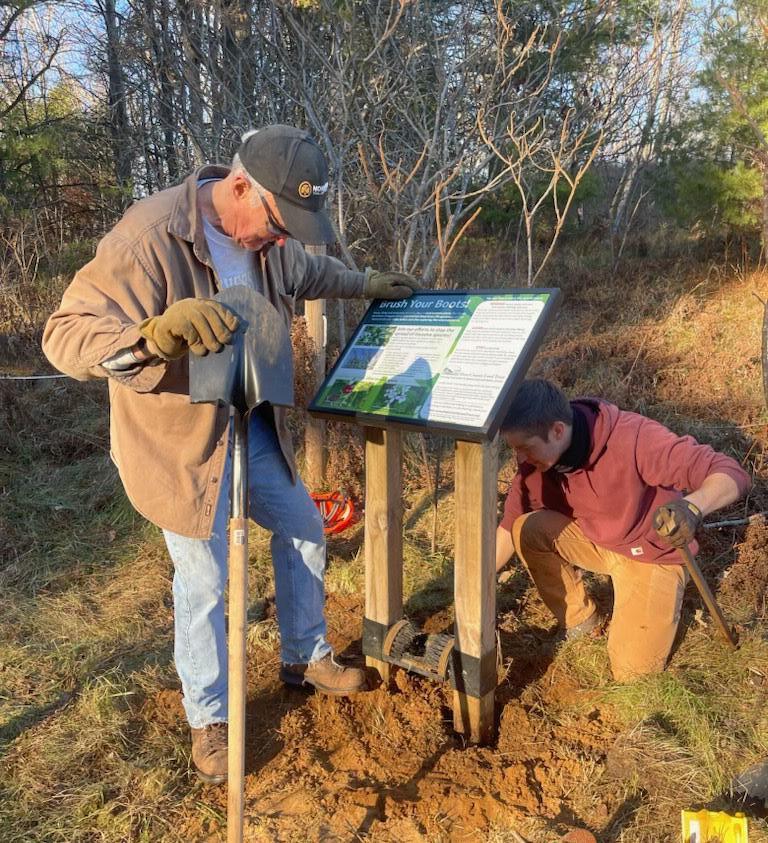
Thank you! Love Heins Creek.

We are eternally grateful for Door County Land Trust! The forethought to protect this precious land is unparalleled. -Jessalynne Adams Nelson
Thank you all for taking care of these beautiful lands. - Denise McGinnis

Landings —Spring 2024 Connecting You to Lands and Waters 4
- Beckie Meerdink Perez
Photo by John Van Den Brandt
Photo by Carrie Ehrfurth
Photo by Drew Reinke
Photo by Kay McKinley
Photo by Dan Eggert
2023 Land & Water Protection For All Living Things

Through community support, the Land Trust completed several land projects in 2023. With the continuing goal of protecting Door County—from its northernmost islands to its southern border—these new lands protect critical wildlife habitat, preserve scenic beauty, and ensure Door County’s rural character remains intact. Of special note is the Southern Door property that will become the Land Trust’s 15th nature preserve.
1. Ursula Petersen donated 10 acres adjacent to the Land Trust’s Coffey Swamp Natural Area on Washington Island. The undeveloped forested wetland will protect more forest canopy of the northern wet, mesic cedar forest in Coffey Swamp. The swamp provides outstanding migratory and nesting habitat for songbirds and waterfowl.
2. The Fischer Family Challenge made possible the purchase of 63 acres that abut Kellner Fen Natural Area. Close to the Lake Michigan shoreline just north of Sturgeon Bay, the addition increases the protection of water quality, land, and wildlife. Several rare species of carnivorous plants and insects like the Hine’s emerald dragonfly reside here.
3. Located west of Kangaroo Lake, the Land Trust’s Hibbard Creek Natural Area expanded with a 77-acre addition of wetland and cedar forest. By extending the natural area’s acreage, an important corridor that permits the movement of wildlife across the peninsula is now permanently preserved. The Land Trust is working with landowners within the Hibbard Creek watershed to strengthen preservation in this crucial wildlife corridor. Story continued on pages 6 and 7.
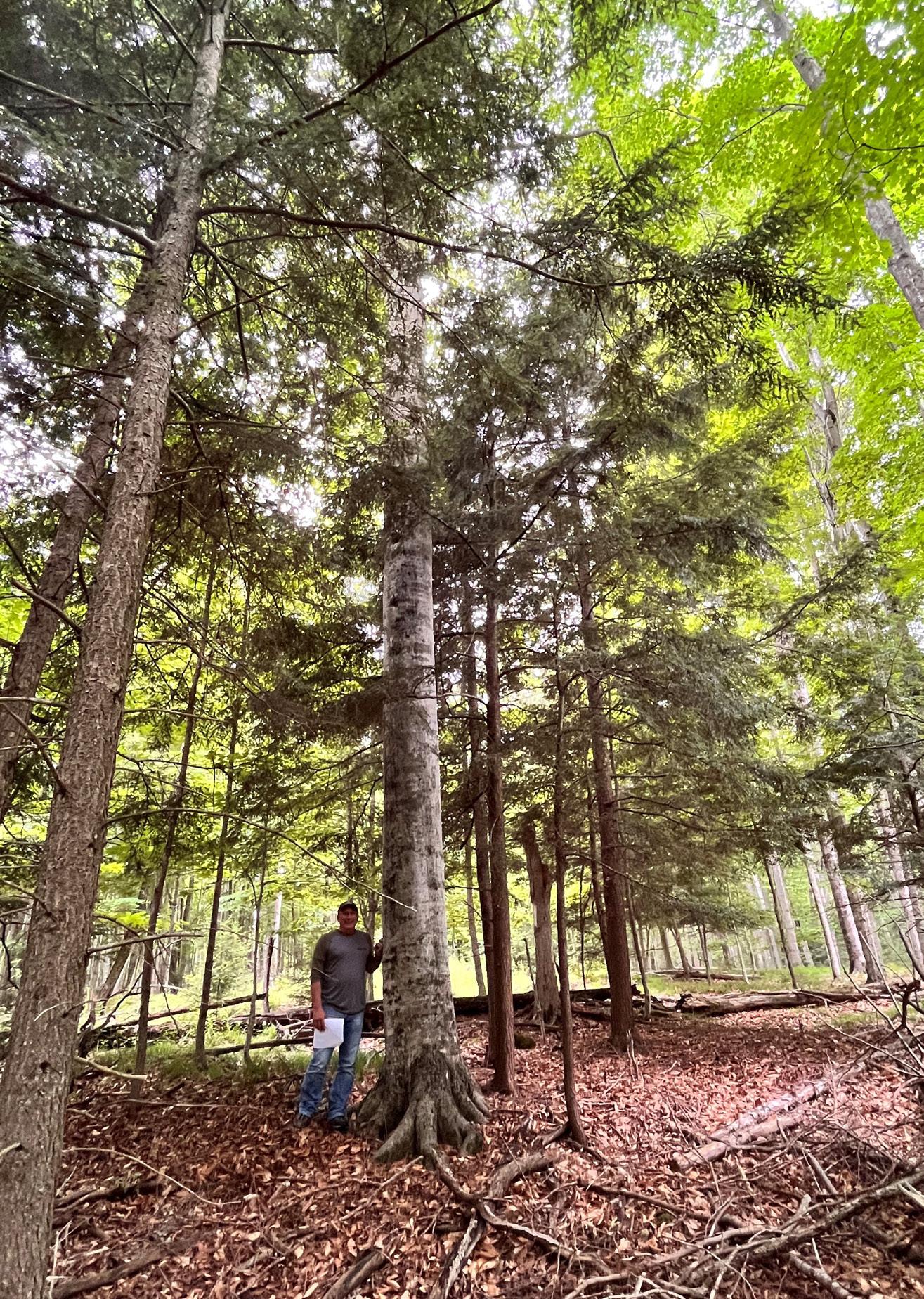
5
Photo by Jeff Lutsey
Landings —Spring 2024
Door County Land Trust
3. Hibbard Creek Natural Area
2. Kellner Fen Natural Area
Photo by Kay McKinley
2023 Land & Water Protection
4. A land donation from the Bogdanowicz family includes 150 feet of Lake Michigan shoreline near the south end of the Land Trust's Legacy Nature Preserve at Clay Banks. The donated property provides additional protection for amphibians, waterfowl, and shore birds.
5. The Land Trust recently protected 119 acres just west of Brussels, now known as Oak Bluff Natural Area. Overlooking the waters of Green Bay, the property includes a mature red and white oak forest at the top of an undeveloped 150-foot-tall bluff edge of the Niagara Escarpment. The property provides migratory bird habitat and grasslands that will be replanted in the coming years with native shrubs and pollinator-friendly perennials.
6. The Land Trust now protects its 15th nature preserve, named Bear Creek Nature Preserve. The first area designated as a DCLT nature preserve in a decade, its varied environments include habitats for a range of species including migratory birds and fish, and grassland and wetland breeding birds. The banks along the half-mile creek provide a buffer zone to filter and clean surface water.
7. A new conservation easement owned by Michael Schmitz protects shoreline property on the bay of Green Bay The agreement with DCLT ensures that the four-acre property, which includes 589 feet of rocky shoreline, will remain undeveloped forever. The easement’s rocky lakeshore and a mature cedar forest provide breeding grounds for migratory songbirds and shorebirds.

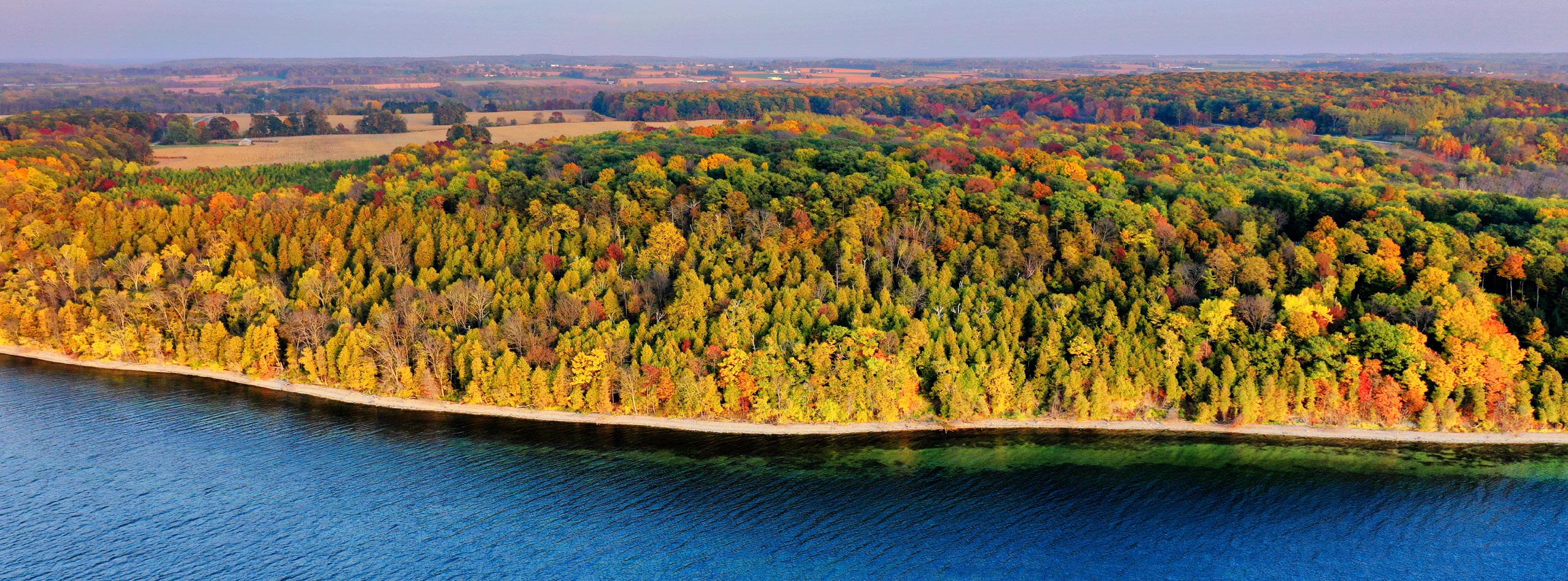
Landings —Spring 2024 Connecting You to
6
Lands and Waters
6. Bear Creek Nature Preserve
5. Oak Buff Natural Area
Photo by Carrie Ehrfurth
Photo by Joe Taylor
For All Living Things

8. Pebble Beach’s 645 feet of shoreline in the Village of Sister Bay is permanently protected. Following successful funding from the Wisconsin Knowles-Nelson Stewardship program, the conservation easement agreement with DCLT was finalized.
9. Private property that bridges wildlife habitats between Peninsula State Park and the Gibraltar-Ephraim Swamp Natural Area is permanently protected through a conservation easement. The 40-acre parcel is along County Road A.

We thank the following partner organizations and agencies for their support of our current land acquisition and stewardship projects.
• Fox River & Green Bay Natural Resource Trustee Council
• Fund for Lake Michigan
• WI-DNR, Knowles-Nelson Stewardship Program
• National Fish and Wildlife Foundation, Sustain Our Great Lakes, in partnership with Lake Michigan Bird Observatory
• USFWS, Great Lakes Restoration Initiative-Joint Venture Habitat Restoration and Protection
• USFWS, Great Lakes Restoration Initiative-Midwest Coastal
• USFWS, Partners for Fish and Wildlife Program





7 Door County
Landings —Spring 2024
Land Trust
Knowles-Nelson Stewardship Program
4. Bogdanowicz Donation
1 2 3 4 5 6 7 8 9
8. Pebble Beach 2023 Land Protection Project Locations
Photo by Dan Eggert
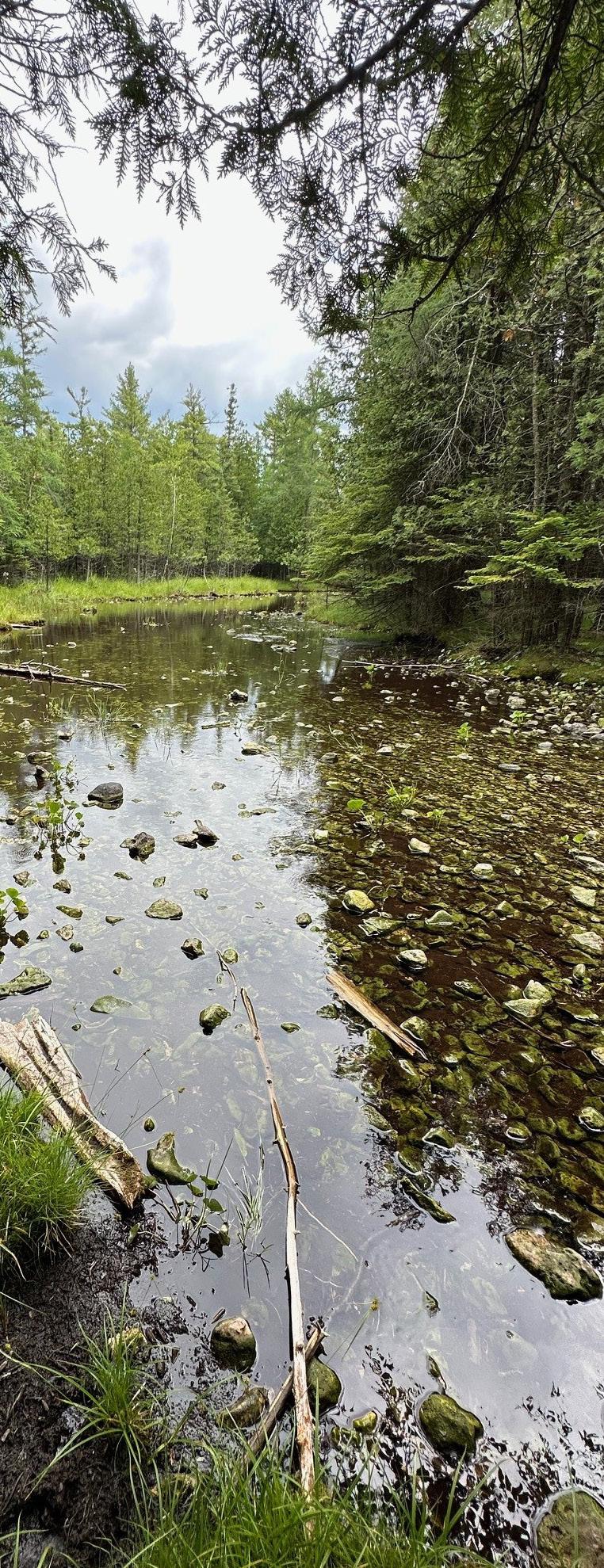
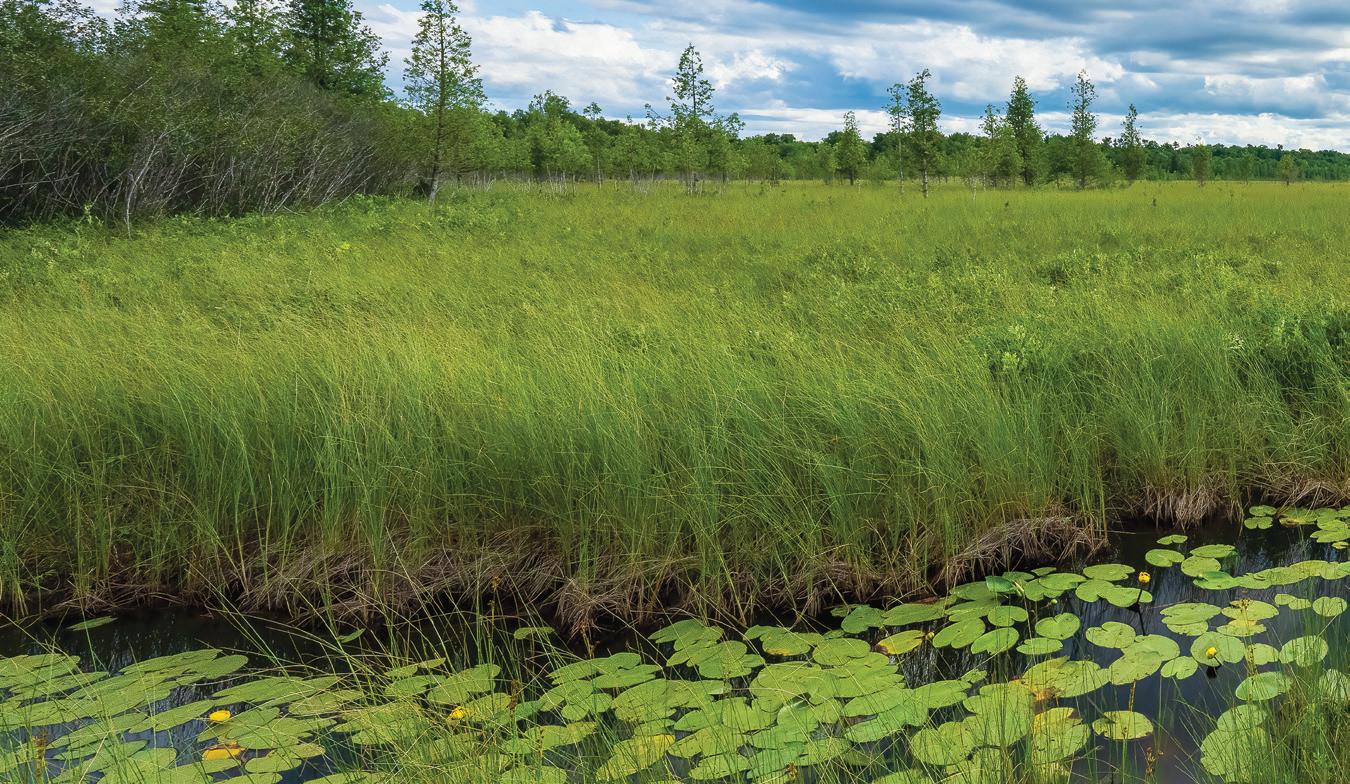
INKING LANDS FOR
Movement means life to wildlife. If conditions of one habitat become unfavorable, wildlife need to be able to leave one habitat for another to meet their needs. The Land Trust is facilitating the protection of wildlife with lands that are connected by being adjacent, or at least near to one another, to form wildlife corridors. According to Land Program Director Jesse Koyen, land protection is the best tool to preserve wildlife corridors.
“The more that lands are connected through corridors, the more resilient the ecosystem,” said Koyen. “Because development is often a barrier to wildlife movement, there are certain habitats that are more of a priority for protection.”
But not all corridors are equal. The type of land in need of protection and the amount of diversity within it must meet the needs of the species that call it home. For birds, contiguous land isn’t as important as having habitats that are within flying distance. A porcupine would require larger, contiguous properties for foraging, shelter, and selecting a mate. Plants that have limited spread for their seed, like the ramshead orchid, also require contiguous habitat for their survival. Recently, the Land Trust has been concentrating on three areas to protect as wildlife corridors: Hibbard Creek Natural Area, Three Springs Nature Preserve, and Kellner Fen Natural Area.
Bay to Lake Corridor, Hibbard Creek Watershed Streams are considered natural corridors. They are easy for wildlife to move along and provide a richly diverse habitat. Hibbard Creek contains a range of species, including aquatic insects and native plants that spawning salmon and trout feed upon. The area’s wetlands and woodlands provide food and shelter for migratory birds like the Sandhill Crane and mammals such as the gray fox.
A recent purchase of land in late 2023 near the Hibbard Creek Natural Area aligns with the Land Trust’s goal to extend protection in wildlife corridors. “Flowing surface water provides more of a connection, it’s more of a linear function.” said Koyen. “If you think of the wetland corridors in Door County, they stretch from one side of the peninsula to the other.”
Landings —Spring 2024 Connecting You to Lands and Waters 8
I L D L I F
W
E C O R R I D O R S
Hibbard Creek photo by Kay McKinley
Kellner Fen photo by David Heilman

PROTECTION
Along with the Land Trust’s Erskine Woods and Solitude Natural Areas, Hibbard Creek Natural Area is within the Hibbard Creek watershed west of Kangaroo Lake. The basin surrounding Hibbard Creek plays an important role in its water quality. The watershed contains bordering wetlands and woodlands that follow Hibbard Creek and filter surface water on its way into Lake Michigan.
The new property contains a drumlin, an elongated hill with rock underneath formed by glacial movement. The drumlin affects the drainage of rain that falls on the property. “Drainage to the west flows to wetlands dominated by white cedar and drainage south flows to our neighboring property, the headwaters of Three Springs Creek,” said Land Protection Manager Brian Forest. “The rain that falls onto this property ultimately drains into Three Springs Creek into North Bay, which drains into Lake Michigan.”
Door County’s Wildlife Corridors
Wildlife corridors are indicated in dark green.
“Corridors like Hibbard Creek, with surface water outside of bay or lake shorelines, are especially important in the spring,” Koyen said. “These are areas with a large number of insects, providing a rich habitat for migratory birds to forage.”
Atop the drumlin are mature aspen, oak, and other plant species common to upland forests. These forests provide habitat for passerine (also known as perching) birds such as Blue Jays, foxes, and other small mammals. To the east of the drumlin is an old hay field that will be restored to prairie for pollinators.
Southern Lake Michigan Shoreline Corridor, Kellner Fen Natural Area
Located near the Lake Michigan shoreline east of the Town of Sturgeon Bay, Kellner Fen is a unique type of wetland that features a large expanse of open water with an extensive, fragile sedge mat that floats on top. This corridor offers an abundance of diversity in landscape and species protection.
The fen is surrounded by dense forests that provide refuge and foraging opportunities for migratory and breeding birds. The fen is also home to several rare orchids and carnivorous
“The more that lands are connected through corridors, the more resilient the ecosytem. Because development is often a barrier to wildlife, there are certain habitats that are more of a priority for protection.”
- Jesse Koyen, Land Program Director
There are two properties under contract to the north and closer to the headwaters of Hibbard Creek that the Land Trust hopes to complete in the summer of 2024. “These lands will enable us to expand our protection of the water quality of Hibbard Creek,” Koyen said.
Three Springs to North Bay Corridor
Three Springs Nature Preserve provides critical breeding habitat for Hine’s emerald dragonfly (HED), the only federally protected animal species in Door County. Two-thirds of the world’s population of Hine’s emerald dragonflies are found in Door County.
The Land Trust has extended its protection within the Three Springs corridor to include an area near the headwaters of Three Springs Creek. By protecting the water quality of the creek, it increases the protection of the HED.
plants, including sundews and pitcher plants. The stream that runs through the property provides habitat for rare species of insects like the Hine’s emerald dragonfly.
Through a generous donation and matching gift challenge initiated by the Fischer family, the Land Trust protected an additional 63 acres in this corridor in June of 2023.
According to Koyen, species diversity and varied sizes of wildlife corridors provide connections that contribute to strong wildlife protection.
“Conservation is practiced on every scale—locally, nationally, and globally,” he said. "The work we do to protect migratory bird habitat in Door County protects the international Mississippi Flyway. Wherever you are, conservation lands are islands of habitat within a sea of development or land use that is not suitable for certain wildlife habitat.”
9 Door County Land Trust Landings —Spring 2024
PRESERVE IMPROVEMENTS Benefit VISITORS and WILDLIFE

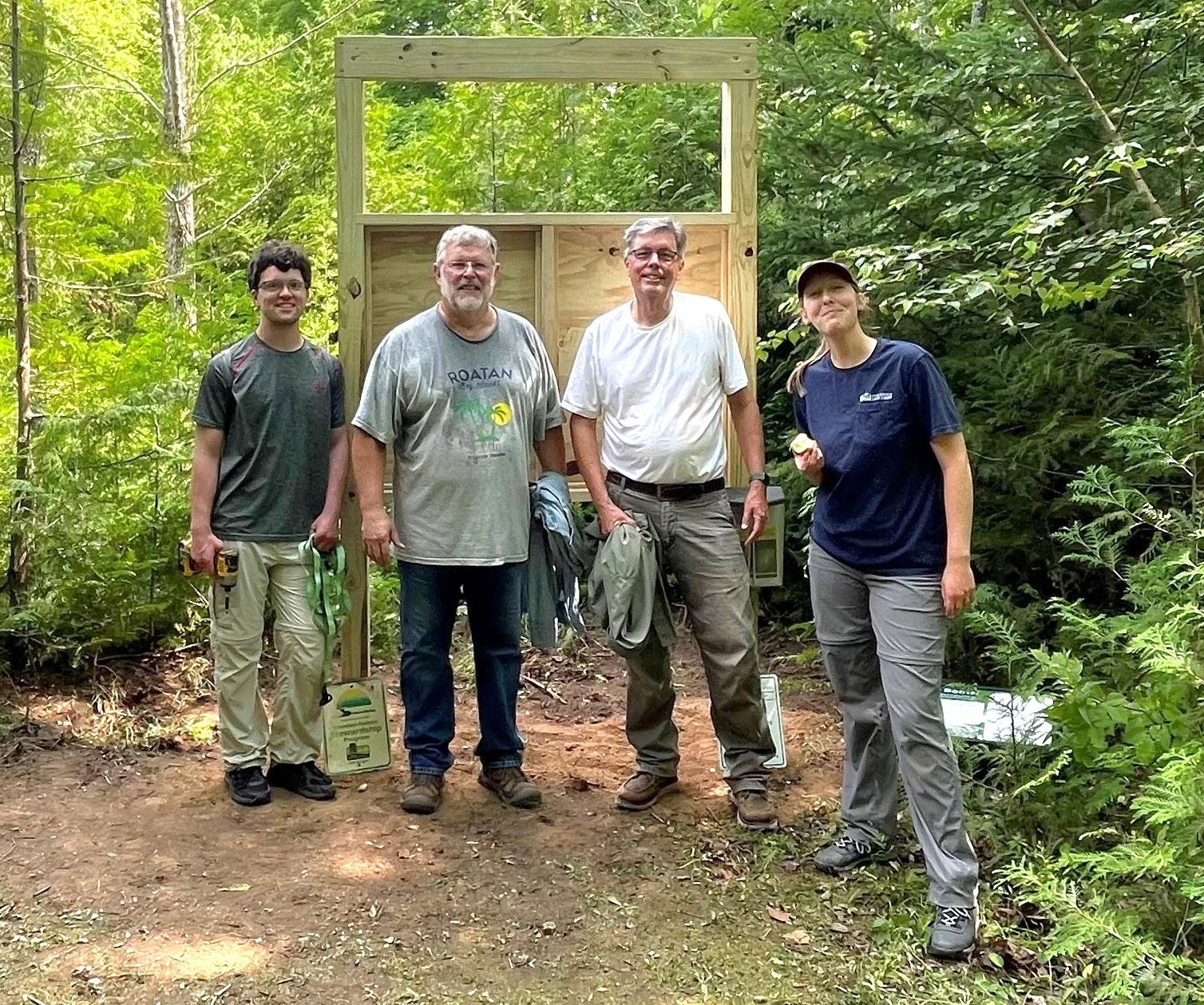
Landings —Spring 2024 Connecting You to Lands and Waters 10
(Left) Volunteer Joe Polacheck helps with the recent seeding at Oak Road Nature Preserve. (Above) A new kiosk is placed at Ephraim Preserve at Anderson Pond.
Photo by Kay McKinley
Stewardship projects in 2023 and 2024 provided enhanced experiences for visitors and increased benefits to wildlife on seven Land Trust nature preserves. The projects would not be possible without community support through donations and hands-on help during Stewardship Workdays. Thank you for your support!
The new trail bridge at Bayshore Blufflands Nature Preserve provides steady footing and a dry crossing for visitors in all seasons. The bridge, which is below the Niagara Escarpment, replaces one that was in disrepair. The bridge spans ephemeral wetlands and is meant to withstand decades of foot traffic. This is good news for year-round hikers who want to experience the escarpment up-close and to witness the beauty of the preserve on top of the bluff.
Little brown bat (Myotis lucifugus) mothers have a safe, protected space to roost at the Three Springs Nature Preserve bat barn due to renovations in 2023. The improvements

The Land Trust provides habitat for grassland birds on the nature preserves by restoring old agricultural fields to prairies. The prairie seeds at Oak Road Nature Preserve were collected and sown by hand during volunteer Stewardship Workdays in August, September, and February. Land Trust stewardship staff took on the seeding of the extensive acreage at Legacy Nature Preserve with the help of a no-till seeder drill.
Winds and weather at Heins Creek Nature Preserve toppled the trail kiosk in July. With the aid of volunteers, including preserve steward John Swanson, the kiosk was up and ready for visitors within a couple of days. Another kiosk was installed at Ephraim Nature Preserve at Anderson Pond during the planned July Stewardship Workday.
New trails at Oak Road and Lautenbach Nature Preserves expand a visitor’s outdoor experience. At Oak Road Nature Preserve, trail work involved the opening of two new trail loops. These rails provide access to both woods and fields. At Lautenbach Nature Preserve, the trail includes

are crucial to the species’ survival as the little brown bat population plummeted due to white-nose syndrome. The bats help provide insect control for area farms. This past fall, reconstruction on the bat barn involved the reinforcement of its frame and the installation of a new roof. When the mothers return to the barn this spring, the updated space will provide a roost for hundreds of bats.
More native habitat for grassland birds is encouraged through seedings at Oak Road and Legacy Nature Preserves. According to Audubon, grassland species are among the most imperiled group of birds in the United States. Total populations have declined more than 40 percent since 1966.
woodlands, Escarpment, and now grassland views. Close to a mile of trail was added at each nature preserve.
Fifteen hundred native trees to be planted by volunteers and staff in April of 2024. Scheduled for two separate Stewardship Workdays, the trees are being planted to restore forests at Bear Creek and Oak Road Nature Preserves. The Bear Creek Nature Preserve planting of 400 trees is scheduled for April 16. In conjunction with the Big Plant—a community-wide event that celebrates Earth Day—1,100 trees will be planted at Oak Road Nature Preserve on April 23. Additional days may be needed to complete the project, which will benefit woodland wildlife and migrating birds. Sign up to plant trees at DoorCountyLandTrust.org/BigPlant.
11 Door County Land Trust Landings —Spring 2024
Volunteer Krista Clarke-Brownstein scatters seed at Oak Road Nature Preserve during a Stewardship Workday.
In cooperation with The Big Plant, join us to plant trees at Oak Road Nature Preserve on Tuesday, April 23, 2024.
Photo by Kay McKinley
Conservation Easements: Private Land for Public Good

Aconservation easement is land protection on a personal level. It’s one landowner’s way to protect wildlife habitat, water and air quality, and the open space and scenic beauty of Door County—while continuing to own and live on the property. Conservation easements protect private land without public access. The conservation easement agreement remains binding, even if the property is sold.
“Private landowners who are uncertain of the future of their property but want to see it protected can enter into a conservation easement agreement with the Land Trust to ensure that the conservation values of the property are protected forever,” said Conservation Easement Program Manager Drew Reinke. “As it relates to development, it’s like a time stamp. No matter what happens to zoning or the sale of a property, the property cannot be subdivided and split up for future development.”
“Owners need to think of their conservation easement as a private land preserve for wildlife habitat,” Reinke said. “They can walk on it, plant native trees and manage their forest, hunt or fish, and even develop hiking trails.”
“There may only be one chance to accept a conservation easement on an ecologically significant or scenic piece of property.”
- Drew Reinke Conservation Easement Manager

Each agreement is as individual as the landowner and the land itself. The size of the easement is up to the owner and what they would like to see protected. Reinke evaluates the land for its conservation values and works with the landowner to honor their long-term vision for the property. In many instances, the conservation easement restricts future building or subdividing. Some conservation easements address whether timber harvest or tree cutting is allowed. Ultimately, the landowner determines how restrictive the conservation easement agreement is.
Placing development restrictions on the property typically results in a reduced property value. However, many income, estate, and property tax advantages come with preserving a property’s conservation value. The donation of a conservation easement to the Land Trust usually qualifies as a tax-deductible charitable gift.
Reinke said it typically takes from six months to a year to complete a conservation easement agreement as easement terms are negotiated, a survey is finalized, and a conservation evaluation of the property is completed.
To date, there are 79 properties (more than 3,500 acres) in Door County protected by conservation easement agreements with the Land Trust. Along with Land Trust nature preserves and natural areas, these easements are integral to protecting the peninsula overall by helping to extend wildlife corridors from Washington Island to Southern Door, while protecting scenic and open space between.
“We have one opportunity to protect land,” Reinke said. “There may only be one chance to accept a conservation easement on an ecologically significant or scenic piece of property.”
Landings —Spring 2024 Connecting You to Lands and Waters 12
The Schmitz conservation easement provides migratory bird habitat along the Green Bay shoreline.
Discovering COMMON GROUND in Land Protection
Mike Schmitz took a date to the Land Trust’s 2022 Annual Gathering and ended up with a conservation easement. At the Gathering, he discovered that his date, Ginny Bolger, shared a passion for conservation equal to his own. Bolger influenced Schmitz’s timing for entering into a conservation easement agreement with the Land Trust this past December.
“It's wonderful that Ginny believes as I do—and I wanted to do a conservation easement at some point—but she urged me to get it done,” Schmitz said. “It’s giving me wonderful satisfaction to know that I’m leaving a legacy that will live on for generations after me.”
Schmitz has supported the Land Trust for over 20 years. It was at the Gathering that Bolger revealed to him that she was a charter member of the Ozaukee Washington Land Trust and had been its board president.
“The conversation in the car going home was all about conservation easements,”
Bolger recalled.
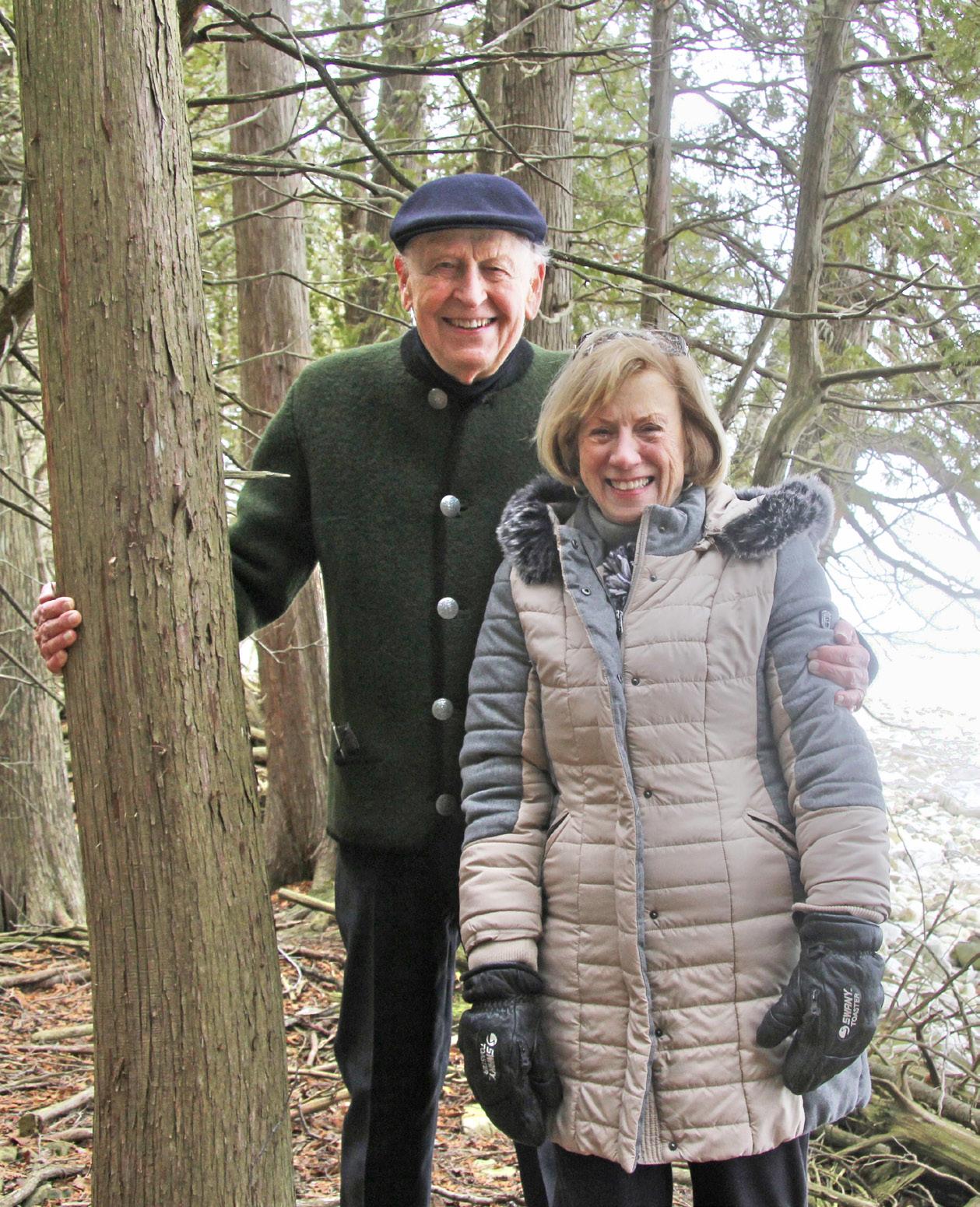
Mike Schmitz and Ginny Bolger’s passion for land protection resulted in Schmitz recently entering into a consevation easement agreement with the Land Trust. Photos by Kay McKinley
There’s a time for everything in life and the time to protect land is now.” - Mike Schmitz
Schmitz and Bolger each had a life experience that inspired them to become conservationists. For Bolger, it was fighting a housing project that replaced an abandoned golf course her neighbors treated as a nature preserve. In his 20s, Schmitz witnessed the rural landscape around his boyhood home become subdivided. His father made an impression on him by planting 5,000 trees rather than selling his land.

The discussion included the parcel that Schmitz was considering for an easement. Since its completion in December, the conservation easement agreement ensures that the property, with 589 feet of rocky shoreline and mature cedar forest, remains protected forever. A short distance to Ellison Bay Bluff County Park and Grandview Scenic Overlook and Park, the property is also part of a wildlife corridor that caters to migratory songbirds and shorebirds and is buffered by the Niagara Escarpment.
“When you live here, it doesn’t take long to appreciate what a wonderful thing we have on the Door peninsula,” Schmitz said. “We must do everything we can to preserve it.”
Schmitz sees people’s role in land protection as guardianship rather than ownership. “We have an obligation to pass as much of this beauty and naturalness on to the next generation as we can,” he said. “I’m not against development, but I am against development that offends nature, that destroys genuine beauty. There’s a time for everything in life and the time to protect land is now.”
13 Door County Land Trust Landings —Spring 2024
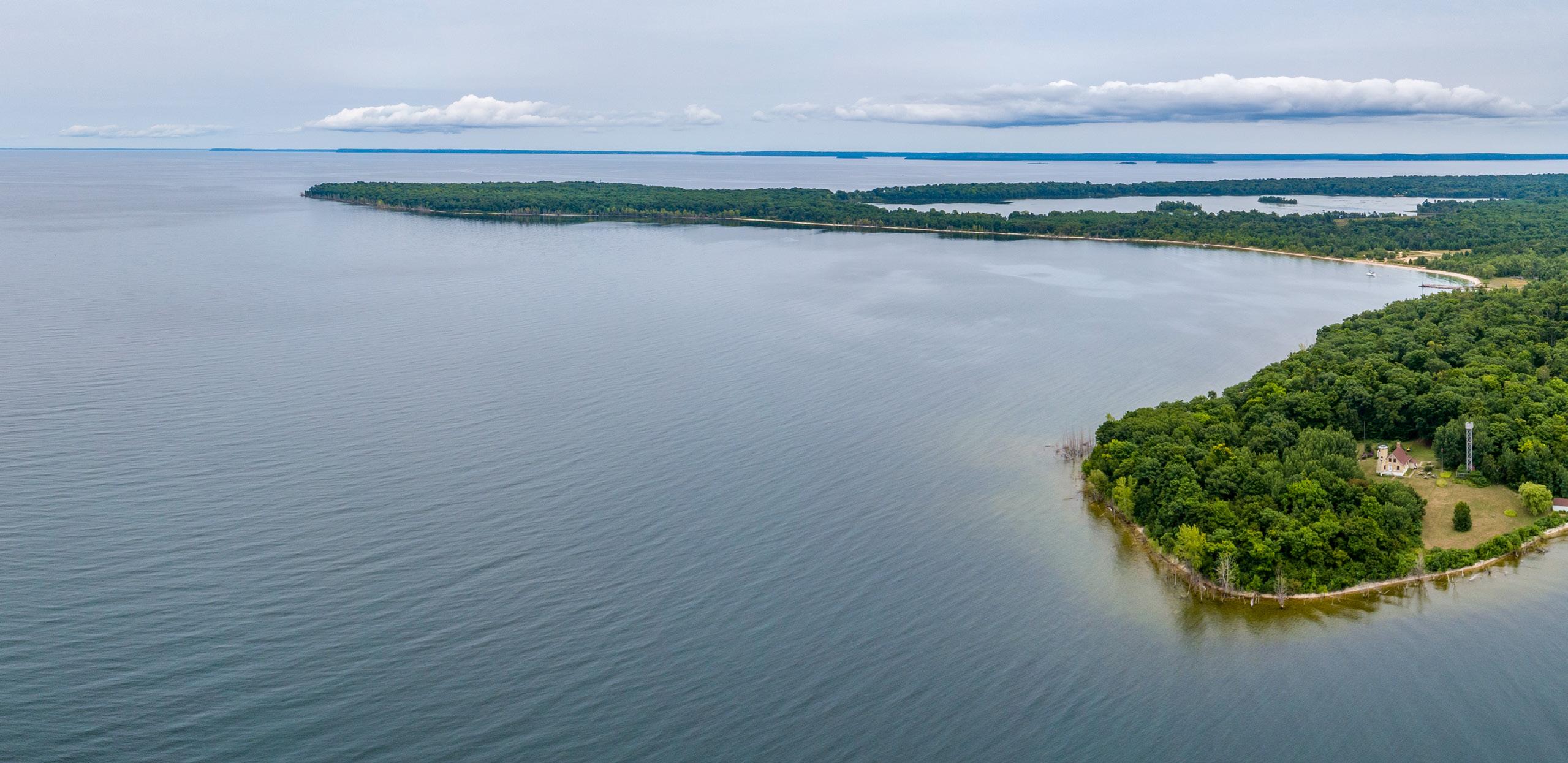
Door County’s Islands: Links in the Flyway’s Chain
Aflicker of golden yellow within a highbush cranberry sh rub is a sign to Washington Islanders that the Yellow Warbler has returned, and spring bird migration is in progress. It’s hard to imagine the extreme effort it took for this tiny bird to fly from Central or South America to find the appropriate conditions to start a family in Door County. The Yellow Warbler is one of over 325 avian species that follow the Mississippi Flyway to migrate to breeding grounds that range from the northern United States to lands within the Arctic Circle.
Numbers do not tell the whole story of Door County’s importance to bird migration, but they certainly are impressive. According to the National Audubon Society, as part of the Mississippi Flyway, Door County and its islands
“Without the islands, birds would need to fly further to refuel, costing them energy that they may not have. By the time they get to Wisconsin, their fat reserves have been significantly depleted,” said Land Program Director Jesse Koyen. “Having these places to stopover and feed—especially these very rich sites with a lot of mayflies and caterpillars that hatch out in the spring—are necessary for these birds to continue with their migration to their breeding ground.”
As forest birds are dependent primarily on insects for fuel in the spring, the timing of bird migration ideally coincides with the peak of the insect hatch. While mayfly hatch depends on water temperature, other insects feed on the sap of budding trees. Timing is everything. Annual weather variability and climate change presents a huge challenge to migrating birds.
“Without the islands, birds would need to fly further to refuel, costing them energy that they may not have... Having these places to stopover and feed...are necessary for these birds to continue their journey to safe breeding grounds.” -
host half of North America’s bird species and up to forty percent of the continent’s waterfowl during migration. As part of the lands connected within the flyway, Door County is a crucial stopover for birds to complete their migration, which directly affects their survival.
Door County’s shoreline and lands with surface water offer migratory birds opportunities to find food, particularly insects, and shelter. Chambers and Washington Islands extend the resources that are found along the peninsula’s shoreline, providing stepping stones for respite after venturing over water for several miles.
“With climate change, there is a potential for mismatch of when peak insect hatch occurs and the migration of the birds begins,” said Koyen. “Different tree species bud out at different times, affecting insect hatches and food availability for birds, and that’s why it’s essential to protect diverse forested lands. Birds will shift their nesting locations if habitat and food isn’t available, which could affect Door County bird populations.”
The Land Trust’s efforts to protect suitable habitat on Door County’s islands is demonstrated by its management of interior forest and wetlands in the Chambers Island Nature Preserve. On Washington Island, the Land Trust owns and
Landings —Spring 2024 Connecting You to Lands and Waters 14
Land Program Director Jesse Koyen
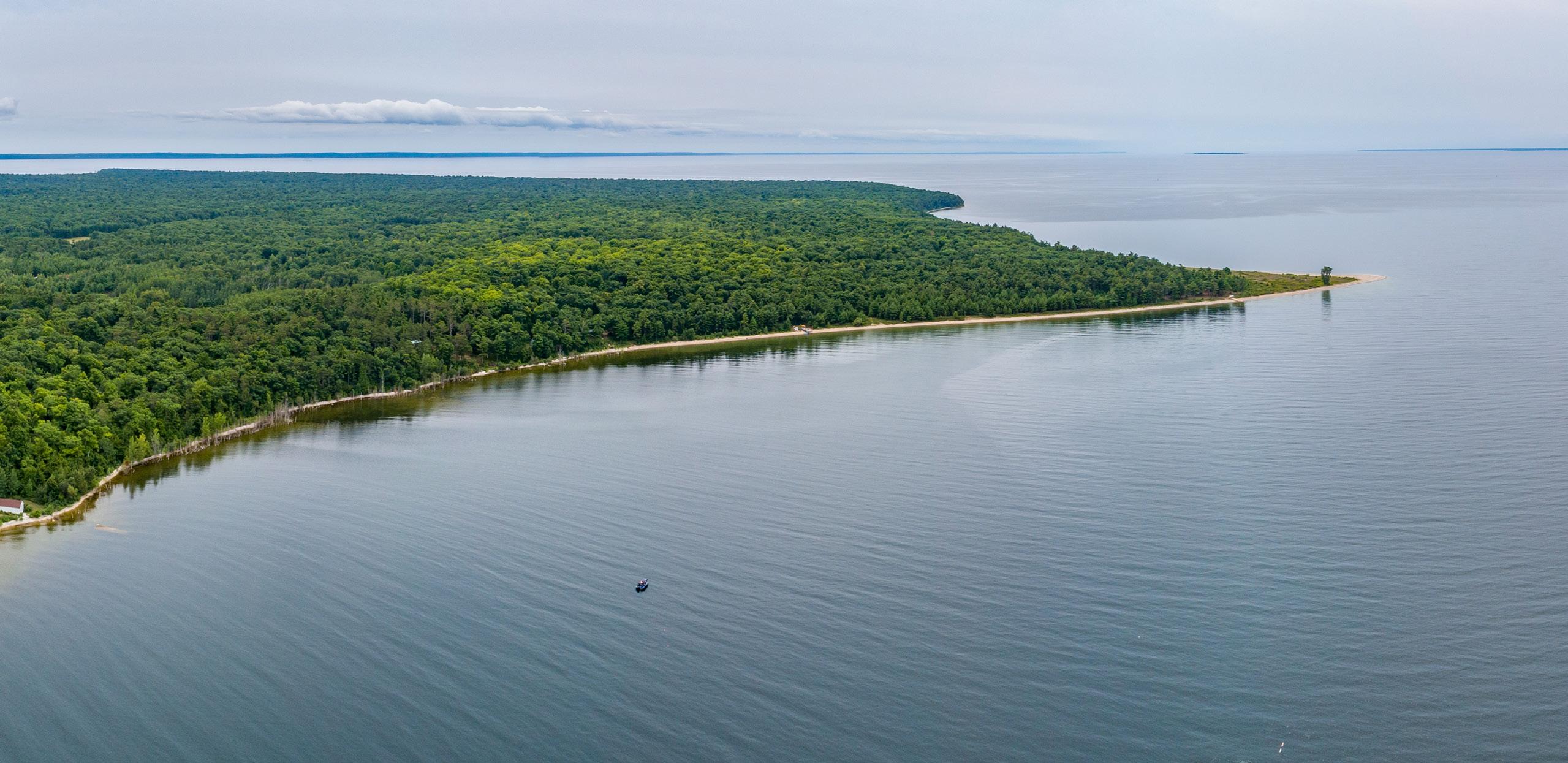
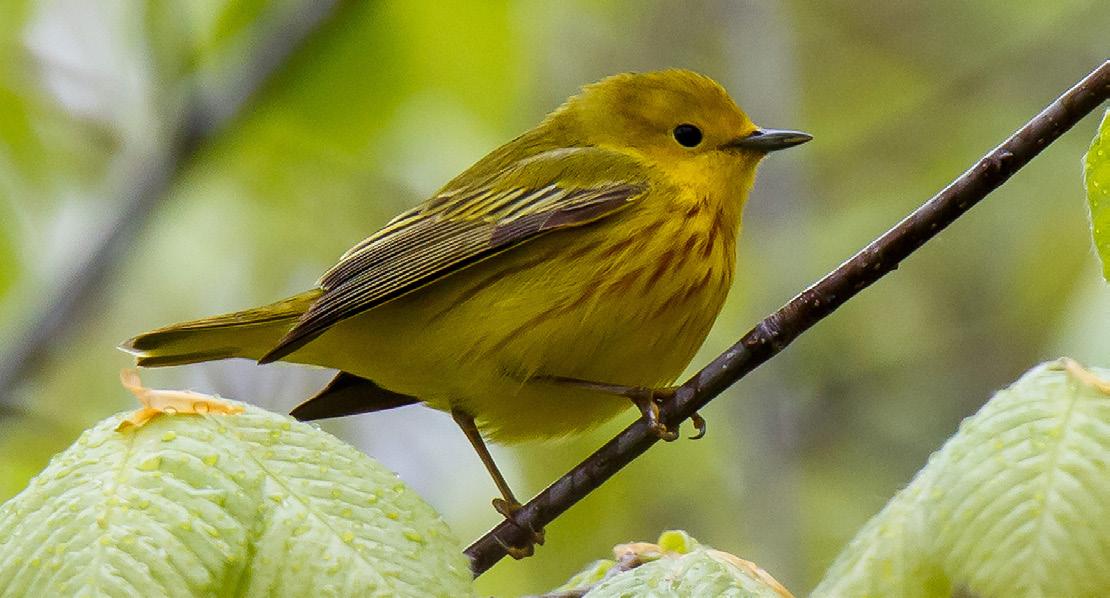
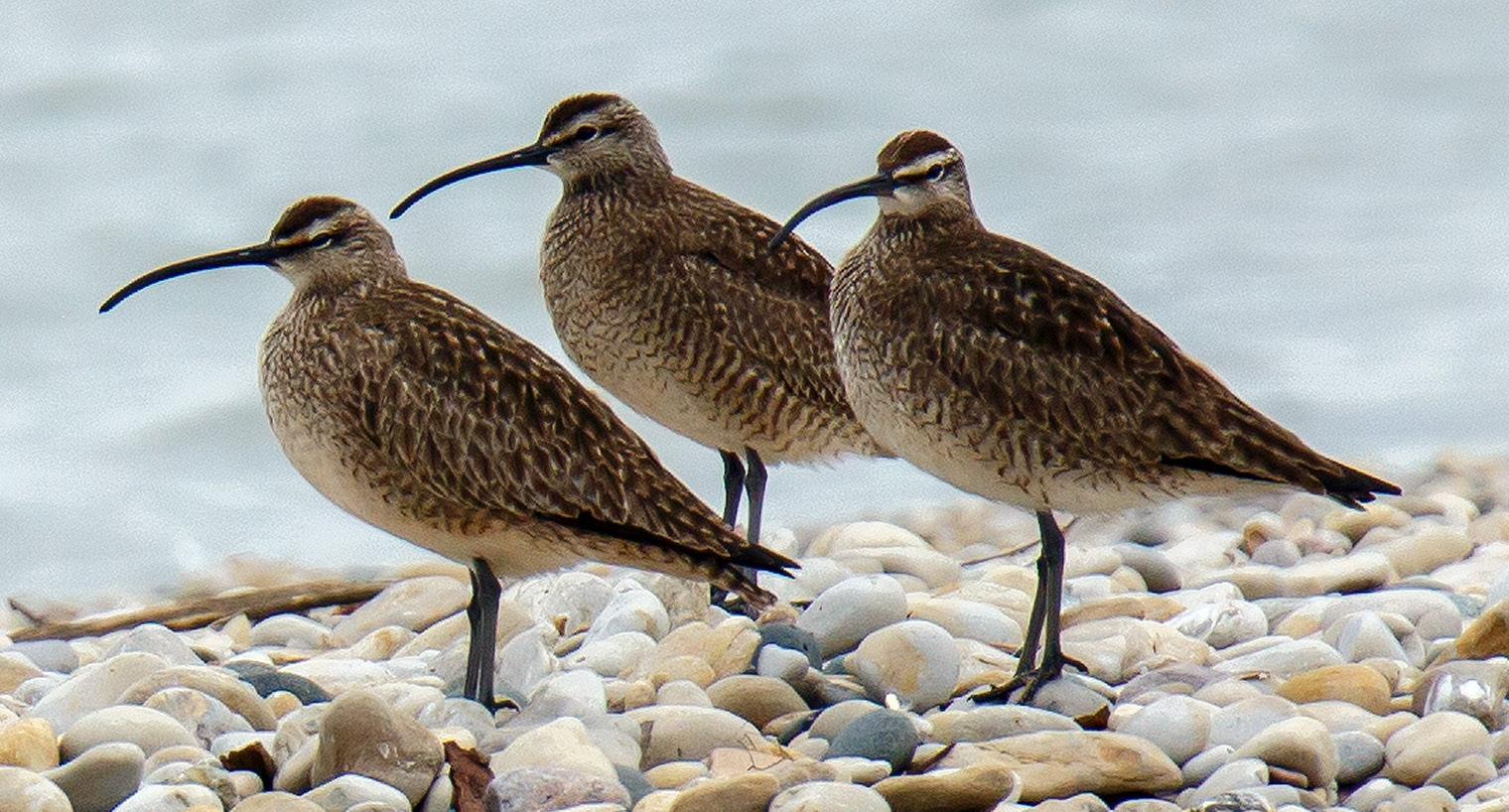
Like Washington Island, Chambers Island (above) hosts hundreds of avian species that migrate every summer to their breeding grounds in the north. Among the winged visitors are the Yellow Warbler (left) and Whimbrels.
manages land within DNR state natural areas, including Coffey Swamp and Big and Little Marsh. The island’s Little Lake Nature Preserve contains Lake Michigan shoreline and Little Lake, the only lake on the island. A recent land donation is adjacent to the Land Trust’s Stillpoint Natural Area, connecting two protected properties.
For the link that Door County provides for migration, there is some good news. “Being near a large body of water means that habitats in Door County will probably be more resistant to the effects of climate change,” Koyen said. “Lake Michigan is going to be a good moderator.”
A Motus Wildlife Tracking System receiver was installed in July at the Domer-Neff Nature Preserve and Bird Sanctuary on Washington Island. The data provided by the receiver—which includes local population size, critical habitat, and migration patterns—will help the Land Trust identify areas of concern for migrating birds. Understanding migration patterns will influence the types of habitats the Land Trust prioritizes for protection in the future.
Loss of suitable habitat is the single greatest threat to birds in North America. As Door County is part of the Mississippi Flyway, problems that impact migration along the route also impact the health of the migratory birds in Door County. For example, a combination of dams, locks, and levees have reduced the Mississippi River to less than ten percent of its original floodplain. An estimated nineteen square miles of delta wetlands are disappearing annually.
“When it comes to migratory forest birds on the land, the quality of those lands for habitat will impact species survival,” said Koyen. “We are just part of the story and what we do here matters; it is a global responsibility. We cannot do it on our own. All along the flyway stopover habitat is needed. The time is now to protect the places that are necessary for these species to survive.”
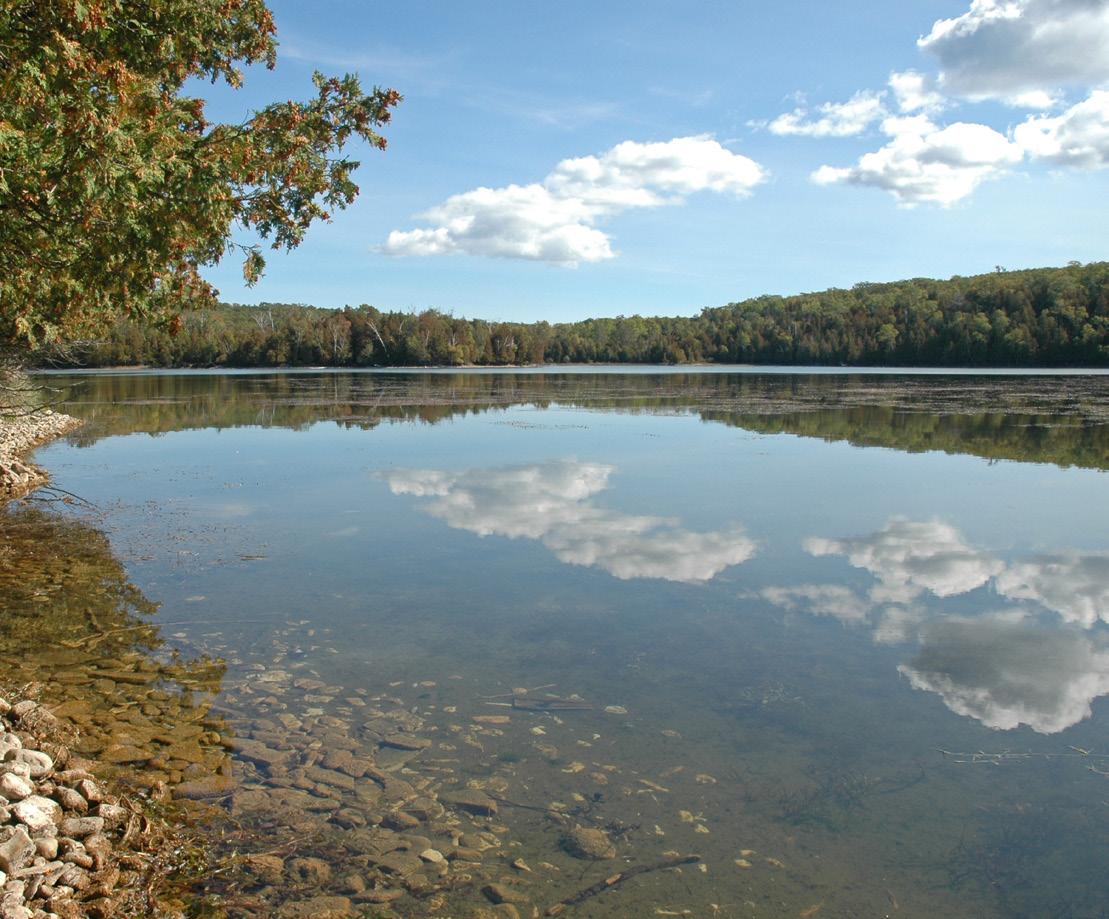
15 Door County Land Trust Landings —Spring 2024
Bird photos by Naseem Reza. Chambers Island photo by Dan Eggert
Little Lake on Washington Island is an important stopover site for migrating birds. Photo by Julie Schartner

Citizen Science: Connecting Volunteers to Field Research
For volunteers, citizen science is a numbers game. Volunteers collect data in the field, which helps researchers and the Land Trust discover trends that guide our work.
“Citizen science projects help us understand the relationships between living things and this insight helps us determine how we can better protect and manage lands for those creatures,” said Community Conservation Coordinator Paige Witek. “By submitting the information to larger databases, we are linking volunteers to a larger conservation effort.”
“Citizen science projects help us understand the relationships between living things, and this insight helps us determine how we can better protect and manage lands for those creatures.”
- Paige Witek, Community Conservation Coordinator
The Land Trust is engaged in two citizen science projects, with a third to be introduced this summer. One of the current projects involves observing pollinator insect interactions with plants at the Sturgeon Bay Ship Canal Nature Preserve. The second is nest box monitoring, which takes place at five of the Land Trust nature preserves. The Land Trust begins a third citizen science project with the Wisconsin Bumble Bee Brigade (WBBB) this summer.
The pollinator observation data collected by volunteers at Ship Canal Nature Preserve is organized by Witek and then submitted to the Chicago Botanic Garden’s (CBG) Budburst platform. The Budburst program gathers data from volunteers nationwide and is now showing the relationship between seasonal changes of plants and insect pollinators. Of particular interest to the Land Trust is the interaction between insect pollinators and the federally threatened Pitcher’s dune thistle (Cirsium pitcheri)—found only on the shores of Lakes Michigan, Huron, and Superior—and at the Sturgeon Bay Ship Canal Nature Preserve. Armed with new data from the Ship Canal pollinator observations, the Land Trust and Chicago Botanic Gardens are better able to conduct targeted habitat restoration work.
In the Land Trust’s other current citizen science program, volunteers monitor 28 Eastern Bluebird boxes, six American
Kestrel boxes, and seven Wood Duck boxes. The monitoring schedule is determined by the temperament of each species. “The chicks and parents of some species become more nervous than others, and we don’t want to disturb them,” said Ecological Restoration Manager Tina Lee.
Bluebird boxes are visited once a week, American Kestrels every couple of weeks, and wood ducks are checked via trail cameras when it is convenient for the volunteer.
Volunteers gather data that tracks avian development from egg to fledge. Lee submits the volunteers’ observations to the Bluebird Restoration Association of Wisconsin (BRAW) and the American Kestrel Partnership. Eastern Bluebirds and American Kestrels, both cavity nesting birds, are seeing positive comebacks thanks to nest box programs. The benefit of the nest box program is two-fold: the boxes add breeding sites, while the monitoring ensures that the young are protected from disease, parasites, and predators.
The Land Trust will launch a third citizen science program this year, the Wisconsin Bumble Bee Brigade. Coordinated by the Wisconsin DNR, the program conducts monitoring of the state’s native bumble bees. In Wisconsin and throughout the world, many bumble bee populations are in trouble. The Land Trust’s Bumble Bee Brigade training will be held in June and counts are scheduled for July and August.
Witek said a volunteer’s conservation ethic grows as their knowledge increases. “During a project, a volunteer becomes motivated to take further action to protect what is observed,” she said. “These projects are an important way to involve volunteers on a personal level in the work of the Land Trust.”
To join Land Trust’s citizen science programs, please visit DoorCountyLandTrust.org/science.
Landings —Spring 2024 Connecting You to Lands and Waters 16
Budburst volunteers monitor pollinator interactions with plants at Sturgeon Bay Ship Canal. Photo by Paige Witek
Free Guided Walks, Events & Workdays

Stewardship Workdays Guided Walk Members Only Event Color
Key:
April 16, 10:00 am - 12:00 pm
Stewardship Workday
Bear Creek Nature Preserve Tree Planting.
April 20, 9:00 am - 11:00 am
Door County Geology Hike with Brian Forest
Lautenbach Woods Nature Preserve
April 23, 10:00 am - 12:00 pm
Stewardship Workday
Oak Road Nature Preserve Tree Planting. Become part of The Big Plant!
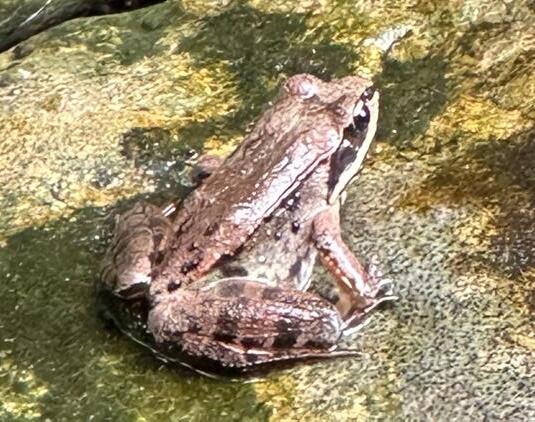
April 26, 7:00 pm - 9:00 pm
Discover Door County’s Frogs & Toads with Jane Whitney Location TBD, depending on spring water levels.
May 3, 8:30 pm - 10:00 pm
An Evening at Nature’s Opera: Frog Chorus with Marilyn Hansotia Ephraim Preserve at Anderson Pond
May 4, 9:00 am - 11:00 am
Creation of a Preserve: Leaving a Legacy of Land with Terrie Cooper and Thomas Stasiak
Legacy Nature Preserve
May 11, 9:00 am - 11:00 am
Spring Wildflowers with John Swanson
Erskine Woods Natural Area Members only
May 14, 8:30 am - 11:30 am
Birding By Ear and Habitat with Carl Cochrane, Bill Utley Sturgeon Bay Ship Canal Nature Preserve
May 18, 9:00 am - 11:00 am
Spring Wildflowers with Mary O’Grady
Gilson-Peterson Forest Natural Area Members Only
May 21, 10:00 am - 12:00 pm
Stewardship Workday
Bear Creek Nature Preserve General cleanup.
June 8, 9:00 am - 11:00 am
Creation of Oak Road Nature Preserve: Farm, Frogs and Forests with Terrie Cooper, Jack Finger
June 11, 10:00 am - 12:00 pm
Stewardship Workday
Sturgeon Bay Ship Canal Nature Preserve Hand pull forget-me-nots.
June 15, 10:00 am - 12:00pm
NEW Southern Door’s Oak Bluff Natural Area with Terrie Cooper and Brian Forest
Directions with registration Members Only
June 18, 10:00 am - 12:00 pm
Stewardship Workday
Gilson-Peterson Forest Natural Area
Hand pull forget-me-nots.
June 21, 9:00 am - 11:00 am
Heins Creek Aquatic Creatures Discovery Adventure with Terrie Cooper, Paige Witek, John Swanson & Kris Smith
June 27, 10:00 am - 12:00 pm & 1:00 pm - 3:00 pm
Washington Island
Preserves Open House Hikes with Terrie Cooper, Jesse Koyen
Directions with registration
July 11, 1:00 pm - 3:00 pm and July 13, 9:00 am - 11:00 am
Creation of Bay Shore Blufflands Nature Preserve, Making the Impossible, Possible with Terrie Cooper
July 16, 9:00 am - 11:00 am
Stewardship Workday
Heins Creek Nature Preserve Cleanup, boundary markers, garlic mustard, and trail maintenance.
July 18, 1:00 pm - 3:00 pm
Schmitdke Conservation Easement Hike in Southern Door with Drew Reinke, Erich Schmidtke
Directions with registration Members Only
July 19, 7:30 pm - 9:00 pm
Saving the Bats at Three Springs Nature Preserve with Marilyn Hansotia
July 25, 1:00 pm - 3:00 pm and July 27, 10:00 am - 12:00 pm
NEW Bear Creek Nature Preserve with Brian Forest and Terrie Cooper
Directions with registration
August 3, 1:00 pm - 3:00 pm
The Buzz About Bees with Emily Roedl, Jody Selenica & Linda Moore
Oak Road Nature Preserve
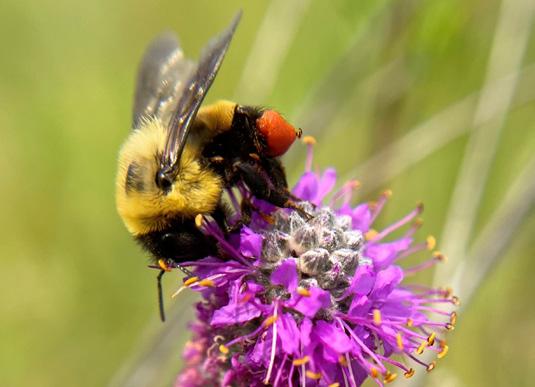
August 15, 1:00 pm - 3:00 pm
Explore Door County’s Forests with Roxanne Hanney and Rob Watson
Lautenbach Woods Nature Preserve
August 20, 9:00 am - 11:00 am
Stewardship Workday
Hibbard Creek Natural Area Trail maintenance, updating signs, general cleanup.
August 24, 9:00 am - 11:00 am
Creation of the Kangaroo Lake Nature Preserve with Lucy Klug, Terrie Cooper
September 4, 8:45 pm - 10:45 pm
Tour of the Dark Sky: Deep Sky Astronomy with James Krumenacher
Directions with registration $15, Members Only
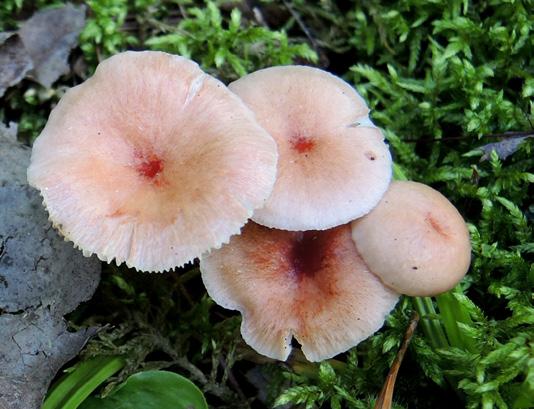
September 7, 9:00 am - 11:00 am
NEW Hibbard Creek Natural Area with Brian Forest, Terrie Cooper
Directions with registration Members Only
Sept. 17, 10:30 am - 1:15 pm
Varies, depending on ferry times. Stewardship Workday
Washington Island, DomerNeff Nature Preserve and Bird Sanctuary Clearing brush.
September 19, 1:00 - 3:00 pm
The Fungus Among Us: Fungi & Mushrooms with Charlotte Lukes
Lautenbach Woods Nature Preserve, $10
October 5, 9;00 am - 11:00 am
Creation of the Sturgeon Bay
Ship Canal Nature Preserve with Terrie Cooper
October 12, 9:00 am - 11:00 am
Fall for Autumn Foliage with Jane Whitney
Kangaroo Lake Nature Preserve
Oct. 15, 10:00 am - 12:00 pm
Stewardship Workday
Oak Road Nature Preserve Seed Collection.
17 Door County Land Trust Landings —Spring 2024
Registration required at DoorCountyLandTrust.org/events
Joy Found in Nature Inspires Legacy Circle Gift
On paper, Bob and Ann Anderson may seem unlikely candidates for the Legacy Circle. They have yet to hike the trails, go to events, or volunteer with the Land Trust. But they do possess a trait that makes the couple a logical choice: a belief in the mission of protecting land.
“We both like animals and nature,” Bob said. “We have 75 acres south of Sturgeon Bay and planted 40 acres in tall grass prairie. We wanted to include the Land Trust in our estate plan to support the protection of natural properties in Door County.”
The Andersons learned of the Land Trust through friends, the Peninsula Pulse, and Landings newsletters, as well as owning a house across the street from the former Land Trust offices.
Before making the decision to include DCLT in their will, the couple did some online research regarding the Land Trust’s business practices as a nonprofit. Gaining confidence with what they found, they took the next step and put the Land Trust in their wills.
“We wanted to include the Land Trust in our estate plan to support the protection of natural properties in Door County.”
- Bob Anderson, Legacy Circle member
Bob received a degree in freshwater ecology from UW-Stevens Point. After graduation, he headed to California to act as a river guide before becoming a metal sculptor. He met Ann, who worked in human resources, in Sacramento. The Andersons remained in California until 2003 when they moved to Door County after finding affordable land that provided space for his sculpture studio and land to enjoy living within nature.
Their desire to conserve land was influenced by living in California and witnessing constant development. That experience inspired them to join the Land Trust’s Legacy Circle. “A lot of land gets developed in California, so we were thinking if we can protect more land that would be a good thing,” Bob said.
With land in Southern Door for Bob’s business, the Andersons reside in Algoma. The property south of Sturgeon Bay, which is on the Ahnapee Trail, gave the couple the opportunity to take conservation into their own hands by converting an agricultural field to prairie.
“We do notice a big difference between having an agricultural field and a grassland as far as wildlife is concerned and we’re enjoying it,” Bob said. “I walk through the prairie and find several bird nests. We also see a lot more insects in the area—be it grasshoppers or dragonflies— and a lot more mice and voles. Raptors cruise our fields all year long.”
By joining the Legacy Circle, the Andersons have made a commitment that will honor their passion for wildlife forever. In this way, the sharing of their joy is guaranteed. For more information about the Legacy Circle, please visit DoorCountyLandTrust.org/LegacyCircle
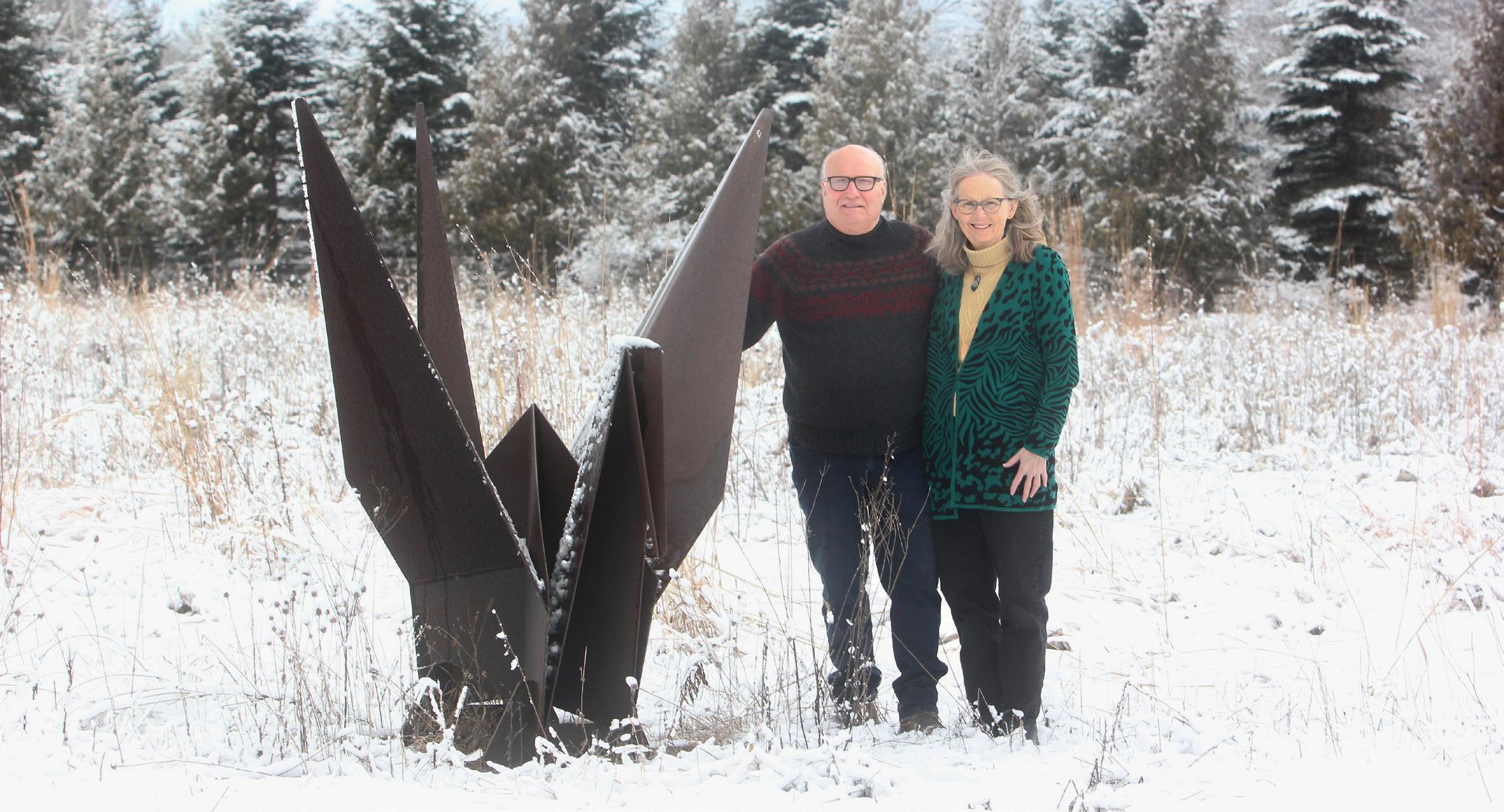
Landings —Spring 2024 Connecting You to Lands and Waters 18
Ann and Bob Anderson with one of Bob’s crane scuptures on the land they restored to native prairie. Photo by Kay McKinley
Every donor is a member of the Door County Land Trust. Your donation will help to protect unique lands and waters, will preserve the rural character, and will safeguard the open spaces and scenic beauty of the Door Peninsula and its islands.
When you join the efforts to preserve Door County’s lands, waters, and wildlife, you’ll receive a new member packet to introduce you to the protected lands that are free and open to the public for recreation and enjoyment. You also receive the joy that comes from sharing your appreciation of Door County’s cherished lands and waters.
Donate today. Donate with a check or credit card online at DoorCountyLandTrust.org/donate or include a donation when you return the envelope in this magazine.
Donate from your IRA. If you are 70 ½ years old, giving directly from your IRA is a tax-savvy way to make charitable gifts that benefit you and Door County lands and waters. Contact Cinnamon Rossman to learn more. giving@doorcountylandtrust.org or (920)746-1027
Donate stock or appreciated securities. Gifts of appreciated stocks are a tax-wise way to give. Learn how to direct a stock transfer at DoorCountyLandTrust.org/stock.
Give from your Donor Advised Fund. If you currently use a Donor-Advised Fund, you may direct one-time or annual donations to Door County Land Trust.
their will, trust, life insurance, or retirement account.
A group of generous Legacy Circle members will donate $1,000 to the Land Trust in your honor when you inform us of your intention to leave a planned gift to the Land Trust. This means your future commitment to saving land can help right now!
Make a gift in your will or trust. A planned gift doesn’t affect your immediate finances and can be revised at a later date if circumstances change.
Direct your retirement account, bank account, or other investment account. Joining the Legacy Circle can be as easy as naming the Land Trust to receive a portion of your account. Ask your financial institution for a form to designate Door County Land Trust as a beneficiary.
Direct your life insurance. Naming the Door County Land Trust as the full or partial beneficiary of your life insurance can be a straightforward method to create a planned gift.
Use one of your greatest assets to donate a gift of real estate. Gifts of real estate, whether it is your residence or potential conservation land, can benefit Door County Land Trust. Gifts of real estate can create significant tax deductions as well.
Learn more about planned giving at DoorCountyLandTrust.org/LegacyCircle
No matter which method you choose when planning your gift, you’ll want to inform us of your intention. Members who are planning gifts are recognized in the Land Trust’s Legacy Circle.


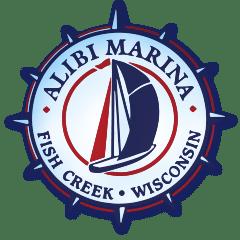


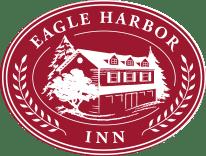



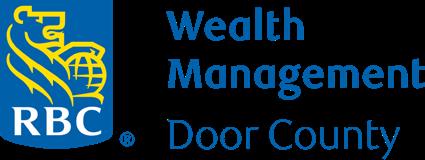



19
County Land Trust Landings —Spring 2024
Door
B F S I N B F S I N Gold sponsors Silver sponsors Platinum sponsors Join us in thanking our Annual Business Members! Ashbrooke Hotel Door County Eye Associates Door County Nature Works Ecology The Garden Lady, Beth Coleman Gills Rock Stoneware Glidden Lodge Beach Resort Grasse’s Grill Impressions Printing & Graphics Jack & Jill’s Landscape Co Jerry’s
Lautenbach Orchard Country Meissner Landscape, Inc. Nicolet Bank Samara Jewelry,
Smile Designs of Door County Dr Timothy Tishler, DDS True North Real Estate Wagon Trail Campground Washington Island Ferry Line Zero Sum Door County
Today. Become a supporting member. Give Forever. Join the Legacy Circle.
is
Flowers
LLC
Give
The Legacy Circle
a group of visionary members who have named Door County Land Trust as a charitable beneficiary in


















 Emily Wood Executive Director
Emily Wood Executive Director






















































